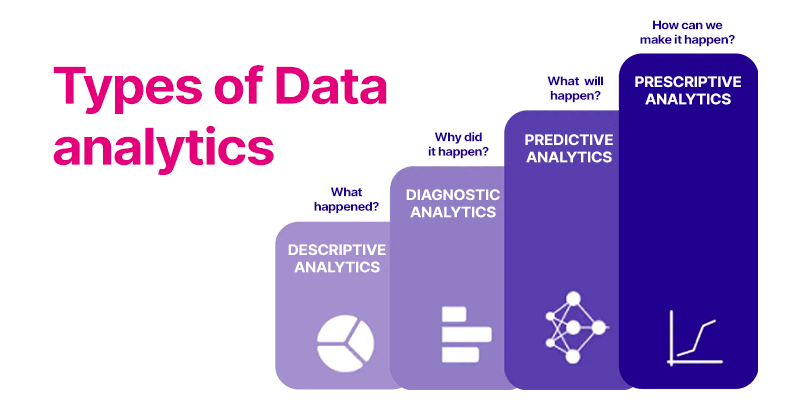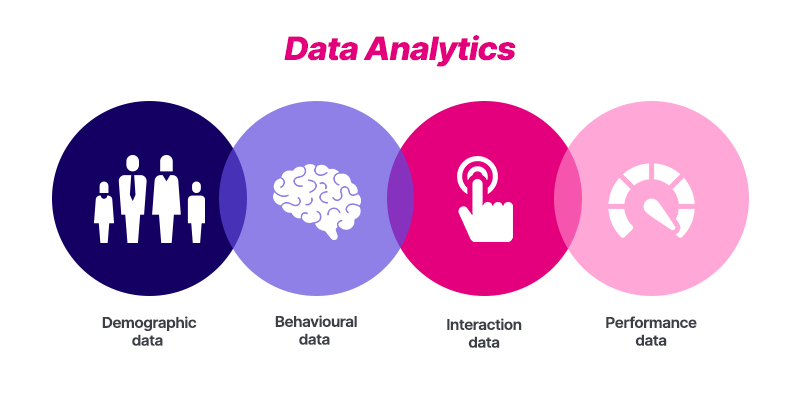In the digital realm, data has become a major asset, both commercially and financially. Consequently, collecting, storing, and analysing data has become a key factor for success in generating growth for any business in its market.
Data Analytics, or the analysis of data, is an essential practice that allows you to understand your audience, activate it, generate sales, or foster long-term loyalty in a highly competitive market.
In this article, we will explore what Data Analytics is, focusing on the different types of data to collect for exploitation. Finally, we will examine the four varieties of analysis that you can perform to obtain crucial insights for your business.
1. What is Data Analytics?
Data Analytics, or data analysis, is a process of collecting, processing, and interpreting data to extract meaningful and useful conclusions. To derive actionable insights from large and diverse datasets, it relies on:
- a combination of statistical techniques,
- mathematical models,
- and computer tools.
The collected data comes from various sources, including websites, social networks, mobile applications, advertising campaigns, sales, and many others.
For further exploration, refer to our article the Big Data and Smart Data.
2. What data can be collected with Data Analytics?
With various data sources available, you can gather a wide range of data, both qualitative and quantitative, about your market, your audience, your clients, or your performance.
 a. Demographic data
a. Demographic data
Demographic data provides information about individual characteristics, such as age, gender, geographic location, education level, marital status, etc.
This data helps you better understand your target audience, personalize your campaigns, and tailor messages based on the specific preferences and needs of your users or prospects.
To collect this data, surveys, registration forms, and cookies can be utilized. You can also rely on your CRM database if this information about your customers is available, in order to create relevant segmentation based on their profile.
b. Behavioral data:
Behavioral data tracks the actions of users as they engage with your website, applications, or advertising campaigns.
By tracking this data, you can gain insights into the user journey or customer journey, such as tracking visited pages, time spent on each page, actions taken (purchases, downloads, clicks, etc.), entry and exit pages, and more.
Utilizing this data helps identify user behavior trends, optimize the user experience, and increase conversion rates.
c. Interaction data
Interaction data encompasses users’ direct interactions with the company, whether through customer service, social media comments, satisfaction surveys, or emails.
This includes zero-party data, which is optional information that consumers voluntarily provide to a company, as opposed to first-party data, which is data collected directly by companies from their audiences, customers and prospects.
This data is crucial for assessing customer engagement, enhancing brand reputation, and identifying potential issues for prompt resolution.
d. Performance data
Performance data measures the results of marketing and advertising campaigns. They provide key information about traffic, conversions, click-through rates, bounce rates, generated revenues, etc.
These are valuable steering tools to guide decision-making and activate the right business and marketing strategies to optimize your return on investment (ROI). Through the analysis of this data, you can invest more effectively in your campaigns and achieve the ROI goals set within your digital strategy.
Important: When collecting and storing data, make sure you comply with the RGPD or nPLD regulations in force, depending on the territory in which you operate.
3. How to collect and leverage this data?
Before implementing a data-driven strategy, you will need to proactively select your future tracking and analysis tools, as well as be capable of storing them.
a. Tracking and Analysis tools
To efficiently gather data, it is essential to implement tracking and analysis tools similar to Google Analytics, Google Tag Manager, Matomo, Adobe Analytics, or specific social media tools.
To achieve this, establish a tracking plan to automatically collect and analyse demographic, behavioral, and performance data.
This will allow you to assess pages, content, navigation plans, or sales funnels with precision and supporting evidence, in order to enhance user experience and promote conversion.
b. Data integration
Data often comes from multiple sources, so it is essential to integrate them into a single platform for storage and to obtain an overview to facilitate their analysis.
Data integration can be achieved through dedicated tools or through specific Customer Relationship Management (CRM) solutions tailored to your company.
To set up and configure the most suitable tools for your company to track your data, rely on a specialized data analysis agency.
How to collect and leverage Data Analytics ?
4. What are the 4 types of data analysis?
When it comes to Data Analytics, we typically distinguish four levels of analysis: descriptive analysis, diagnostic analysis, predictive analysis, and prescriptive analysis. Each of these levels provides different insights and perspectives to assist businesses in making informed decisions and optimizing their performance.

a. Descriptive analysis
Descriptive analysis is the most fundamental level of data analysis. It involves describing and summarizing data in a clear and concise manner. The main objective of this analysis is to provide an overview of past events and current trends:
- Basic statistics: calculations of mean, median, mode, standard deviation, etc.
- Graphs and tables: visual representations of data, such as histograms, bar charts, pie charts, etc.
- Segmentations: dividing data into homogeneous groups for a better understanding of the characteristics of each group.
b. Diagnostic analysis
The diagnostic analysis aims to understand why certain events occurred by identifying the factors or causes that influenced them. It builds upon the results of descriptive analysis to deepen the understanding of the data:
- Correlation analysis: identifying relationships between different variables to understand how they interact with each other.
- Regression analysis: evaluating the relationship between a dependent variable and one or more independent variables to explain variations in the data.
- Causality analysis: determining the factors that led to a specific event.
c. Predictive analysis
Predictive analysis involves using statistical models and algorithms to anticipate future customer behaviors and market trends, based on past and current data. This enables businesses to make proactive decisions, optimize campaigns, and effectively target potential customers:
- Predictive modelling: Utilizing mathematical models to predict future outcomes, such as sales predictions, market trends, etc.
- Time series analysis: Forecasting future values based on historical variations over time.
- Cluster analysis: Grouping similar data to identify patterns and emerging trends.
d. Prescriptive analysis
Prescriptive analysis goes beyond prediction by offering solutions and recommendations to achieve specific objectives. It helps businesses choose the best approach based on previous analysis results:
- Optimization: Identifying the best combination of variables to achieve a defined objective, for example, optimizing advertising expenses to maximize conversions.
- Scenarios and simulations: Evaluating possible outcomes based on different strategies to make informed decisions.
- Expert systems: Using rules and algorithms to provide real-time recommendations.
By combining these four levels of analysis, companies can make the most of their data.
Conclusion
Data Analytics is a powerful lever to assist you in making informed and relevant decisions, forecasting future trends, identifying opportunities and potential issues, with the goal of enhancing your profitability and overall performance.
By collecting and leveraging demographic, behavioral, interaction, and performance data, you develop tailored marketing strategies, enhance user experience, optimize advertising campaigns, and gain a significant competitive advantage in an increasingly competitive digital environment.
As a specialized digital communication agency in data, Eminence aims to optimize return on investment (ROI) and the performance of its clients.
Do you want to learn how to leverage Data Analytics for a tailored marketing strategy?


 a. Demographic data
a. Demographic data